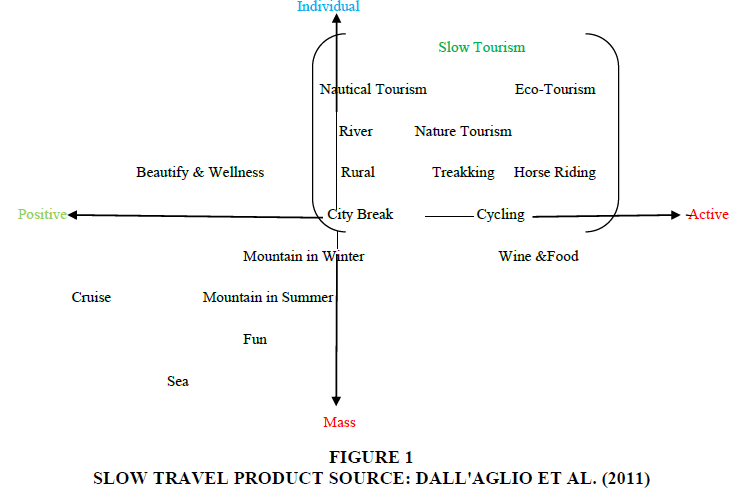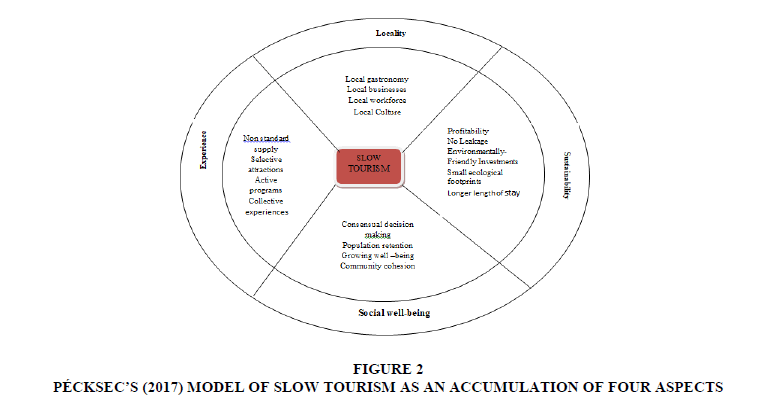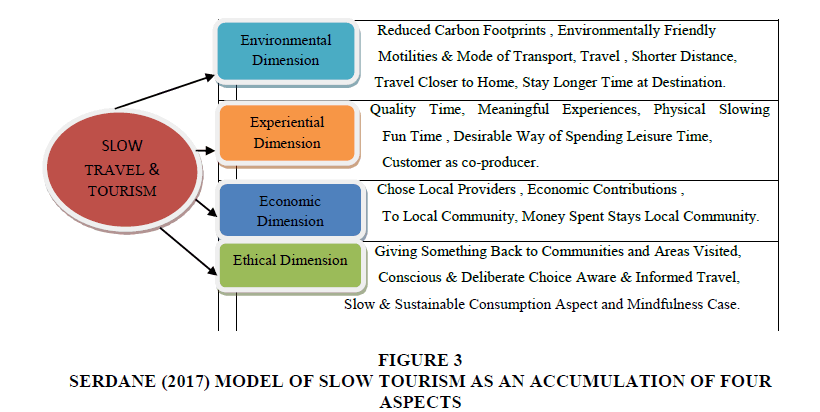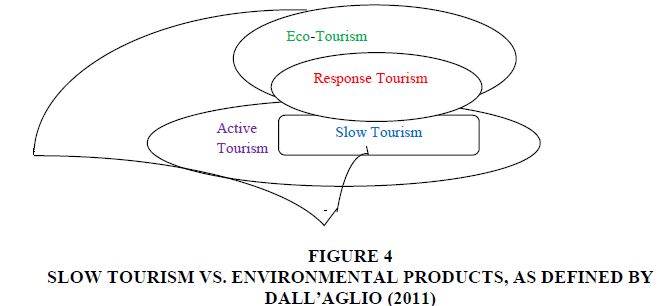Research Article: 2023 Vol: 29 Issue: 2
Exploring the Dimensions of Slow Tourism
Singh Jitendra, IIMT University Meerut
Kumar Siddharth, IIMT University Meerut
Singh Vishvanath, Sushant University Gurugram
Citation Information: Jitendra, S., Siddharth, K., & Vishvanath, S. (2023). Exploring the dimensions of slow tourism. Academy of Entrepreneurship Journal, 29(2), 1-8.
Abstract
The scholastic literature and the subject matter of experts suggest that the concept of “slow tourism” does not have an unambiguous or agreed definition. Authors such as Dall’Aglio (2011), among others, criticize this lack of definition on the coincidences of “slow tourism” with other tourist modalities and the lack of a clear border between those. Slow tourism, “is about slowing down the rate of tourism and a assurance of regain oneself (the physiological and the psychological); it is about low chlorofluorocarbon and it is a analogous, of patience, peace of mind, deeper experiences, refine cultural understanding and knowledge”. Slow tourism means moving at a pace that allows finding. It is to tourism what slow food is to the restaurant business; it is doing away with the distress and speed of traveling, it is accepting a slow momentum as the norm for undertaking one’s leisure activities. The illnesses that our contemporaries suffer from are for the major part linked to stress; based on this observation, slow tourism then appears as a health giving solution as well as one that deals out satisfaction.
Keywords
Slow Tourism, Cultural Understanding, Tourist Modalities, Slow Momentum
Introduction
History, Origin and Development
The much well known ‘slow movement’ sow the seeds of in Italy in 1986, as an innovation of Carlo Petrini. Petrini’s originate the idea of ‘slow’ as a reaction against ‘fast food’ that was put in place through the opening of a McDonald fast food chain unit in Italy. Opposing the incursion made by the worldwide fast food chain, he argued that domestic gastronomic affluence should be conserve, organically grown and locally available rhythmic fresh food should be consumed, customary slow cooking style should be practiced, and food should be consumed leisurely (than be rushed with) in order to aroma the distinct seasoning of the cuisine. Moderately the philosophy of ‘slow’ became globally acceptable and appealing, and consequently filtered into many other aspects of life, creating several new labels that are now identified with the adhere ‘slow’, viz. ‘slow time off ’, ‘slow transport’, ‘slow city’, ‘low inter-linkage ’, etc Khan (2015).
The addition of the slow ideology into the phenomenon of tourism became apparent with the birth of ‘slow tourism’ as one of the offspring of the ‘slow movement’. With respect to travel and tourism, Krippendorf (1984) was one of the earliest scholars to highlight the importance of ‘slowness’. He advised people to take relaxed, enjoyable and environmentally friendly holidays, suggesting they should ‘switch off their time machine, take off the watch, get rid of time pressure, the deadline, the agenda’ (In a way, Krippendorf propounded the idea of ‘escape from time’ (Dickinson et al., 2011).
As a well defined term, ‘slow tourism’ evolved in 1990s. Afterwards, the concept has been continuously gaining acclaim. A number of reasons are accountable for the unfolding of slow tourism. These include, a growing concern towards negative impacts from mass tourism; the introverted trend of withdrawal of tourists into their off the beaten track worlds in a gift wrap ‘environment bubble’, and a fast spreading peripheral consumerist culture attached to material ownerships and comforts, which though clear the way for travel, distances and detaches the tourist from his surroundings, resulting in an overall oversimplified tourist experience. Hence, slowing down in the interest of environment and quintessential experiences rests at the core of slow tourism Butler (1990).
Slow tourism: a functional definition
“In various ancient cultures and philosophies the time was presented as cyclic. Rebirth and renovation of nature created a circle of life which aroused a sense of return. Nowadays, in the societies of Western countries, the time is linear: it proceeds only one way, creating pressures of loss and anxiety. The current manners obligate to make more in less time, even the amount of alternatives is almost endless” (Dall’Aglio, 2011).
Promoter of slow tourism has recognised several principles of slow tourism. A website on slow travel (thewayofslowtravel.com) tracing ten principles for brake the speed of life i.e. (1) slow down, (2) stretch your comfort zone, (3) simplify, (4) let go of the plan, (5) spend less, (6) take root, (7) blend in, (8) rely on strangers, (9) practice gratitude, and (10) celebrate the ordinary. Dall’ Aglio (2011) propound that slow tourism can be explained by the acronym ‘CASTLE’. The six dimensions of CASTLE are, (1) Contamination-signifying meaningful opportunities of exchange, (2) Authenticity-seeking the genuine and original, (3) Sustainability-of environment and culture,(4)Tempo-indicating pace of activity that facilitates comprehension and appreciation, (5) Length-giving time to avail a quality experience at the right pace, and (6) Emotion-connected with memorable experiences. Conceivably, it is the definition of Dall’Aglio et al. (2011), with its conventional simplicity and its ability to collect most of the difference of opinion and attributes confer the one that best defines the concept. As they explain, Slow Tourism is a form of tourism that: “Sensitizes demand and supply of ethical values, allows to get possession of time again, relieves anxiety and stress caused by hectic paces, allows the guests to be back in tune with themselves and whatever surrounds them, creates a new form of awareness thanks to a deeper and involving experience and thus emphasizes sustainability, responsibility and eco-friendliness” of all the collaborator involved. The definition is adaptable with that of Alex Montesinos’, a Spanish specialist and founder of “Entrelenguas” who states that “we define Slow Tourism as a travel philosophy which allows you to see the more authentic side of a destination from the experience of a traveller”
Slow tourist
“Slow tourism stands for the slow values: slow tourist creates meaningful connections with the local people, places, heritage, food and environment. Slow tourist enjoys holistically in the destination without a strict timetable or pressures of "must see".” (Slow Movement, 2013) shows in Table 1 and Figure 1.
| Table 1 Slow Tourism Typology (Heitmann et al. 2011) |
|||
|---|---|---|---|
| Smith (1989) | Cohen (1972 | Plog (2001) |  |
| Charter Tourist Mass Tourist Incipient Mass Tourist Unusual Tourist Off-beat Tourist Elite Tourist Explorers |
Organized Mass Tourist Individual Mass Tourist Explorer Drifter |
Psychocentric/Dependables Near dependables/psychocentric Mid-centric Near Venturer/allocentric Venturers/allocentrics |
|
Figure 1: Slow Travel Product Source: Dall'aglio Et Al. (2011).
Outlook defining slow tourism
Some authors identify the differential attributes of Slow Tourism. Bac Paul (2014), for example, draws up a comparative table between Slow Tourism and fast tourism, or mainstream Conway & Timms (2010) shows in Table 2.
| Table 2 Slow Travel v. Fast Travel Comparison, According To Bac Paul (2014) |
|||||
|---|---|---|---|---|---|
| Type of Tourism | Mode of Travel | Slowness | Travel Experience | Environmental Consciousness | Sense of Place |
| Slow Tourism | Walking/ Cycling | Easy-going | Travelling through the landscape | Low consumption of fuels | Cultural Exchange (attachment) |
| Fast Tourism | Airplane | Push-on | Travel corridor | High consumption of fuels | Minimal cultural contact (detatchment) |
Attributes of Slow Tourism
1. Change in the concept of travel and the use of time during the trip
2. Alternative of mass Tourism
3. Focus on local
4. Focus on cultural
5. Sustainable and natural environment concerns
6. Change in the quality of the experience
7. Authenticity
8. Feasibility and new business development
Fundamentals for the Success of Slow Tourism
Some postulates, which have been bring out from the papers relating to the development of slow tourism, are listed and presented in below given Table 3.
| Table 3 Key Factors Of Success Of Slow Tourism |
|
| Sustainability | Defined as the impact of the tourism activity on the local surroundings economy, and society |
| Learning About Local | The presentation of the activities for slow tourism should exploit resources that are locally available. For example, products, such as local costumes, seasonal fruits, local recipes, and foods, should be presented to the slow tourists. |
| Organic | Foods, that are obtained locally, are the products of the local ecological system. These must be outstanding products from the tourism area that differ from the products in other areas. Therefore, marketing should be encouraged for these types of products, and at the same time, they must be well-preserved. |
| Wellness | The process of fostering “well-being” and the conditions for a “state of wellness” means providing conditions under which tourists can be provided with good food, good accommodations, good company, and high quality products in each tourist area. |
| Time | Defined as “the time dimension of the business and territorial organization” of the activity (long-term planning, dedicated time to improve the business and the relationship with customers, and time availability of services) from the point of view of the supply, and the “right to regain laziness” of the customer, “freeing her/himself of the guilt”. |
| Opportunity | Being located in tourism area, local residents are blessed with the chance to have a better quality of life. Most often tourism can be a big boon to the incomes of families. |
| Understand | With respect to the struggle experienced in developing slow tourism in any area, the residents and all concerned parties can take the opportunities to learn and to further understand the importance of slow tourism |
| Responsibility | Slow tourism should denote the importance of being responsible. When taking tours, the tourists themselves should be conscious and aware. When touring, it is important to take responsibility because, by doing so, the growth of the economy and the community, as well as the protection of the environment, can be accelerated |
| Impression | In tourism industry management, the concept of making a good impression should be endorsed. When the tourists have an appreciation of the tourist attraction, they will return to the same attraction again and again. |
| Satisfaction | A sense of satisfaction should be created for both the tourists and the local residents. The tourists should be left with the feeling that they have not only received great service, but they have been served with high quality products. Similarly, the hosts should feel that it has been worthwhile for them to have good guests. |
| Mobility/Movement | In a slow tourism market, inert movement through various activities, such as meditation and yoga should be provided. Slow activities, such as these, are necessary for slow tourists who want to ponder their lives and to absorb some of the natural power and beauty that surrounds them. By doing so, they can relax both physically and mentally. |
| Emotion | Defined as the “capability to generate memorable moments that make the guest leave as a different person, marked by a true involving and gratifying experience” |
Pécsek (2015) define Slow Tourism as an accumulation of four aspects each, including environmental, experiential, economical and ethical (Serdane) or locality, sustainability, experience focus and social-wellbeing (Pécseck). Both models are very homogeneous on the bottom Joseph & Singh (2013).
According to Pécsek (2015, 2018), slow tourism has four pillars. Locality, sustainability, social well-being, and focus on experience are the fundamentals of the slow tourism ideology (Pécsek, 2014, 2018). These four components advocate sustainable tourism by encouraging sustainable social, economic, and environmental development, as well as individual travel rather than group travel. At the same time, it discourages mass tourism consumption, while supporting the consumption of local and authentic products shows in Figure 2&3.
Tourism activities related to Slow Tourism linked to Sustainable Tourism
Dall’Aglio (2011) has accordingly drawn conceptual figure to define the multiple links between Sustainable Tourism and Slow tourism activities. As shown in below given figure, Sustainable Tourism shares with all these other activities some characteristics shows in Figure 3&4.
Figure 4:Slow tourism vs. Environmental Products, As Defined By Dall’aglio (2011).
a. Brings the expertise to assure long term benefits to the local environment, community, and tourist collaborator, as Slow Tourism does.
b. Recognizes the central role of locals as promoter of their own development of its territory (as responsible tourism does),
c. It allows “travels to fragile, wild and usually protected areas” by “minimizing the impact” over the environment (as eco-tourism does)
d. Pursues “ethic goals” by promoting the education and respect of the traveler (as eco-tourism does)
e. Offers a combination of entertainment, education, observation, respect and interaction with the local environment and community (as active tourism does).
Slow Tourist Profile: Comparision Between Slow & Mainstream Tourist
As a précis of the previous affirmation, it is possible to build a comparative profile of the slow tourist, in contrast to that of the “mainstream” tourist shows in Table 4.
| Table 4 Key Indicators Slow Tourist Profile: Comparison Between Slow Tourist & “Mainstream” Tourist. |
||
|---|---|---|
| Key Indicators | Slow Tourist | Mainstream Tourist |
| Inspiration | From travel books to Internet | Internet |
| Reservation | By phone or e-mail (for a more direct contact) but also Internet | Internet booking engines but also email |
| Use of tour operators | Only if not avoidable | Yes |
| Destination info & maps | From travel guides (paper) to smartphone | Smartphones or tablet |
| Taking pictures | Analogic camera, if possible – Smartphones | Smartphones |
| Use of social networks to communicate trip or pictures | Growing trend | Yes, in every case |
| Personal attitude towards destination, people, and environment | Disconnection” from the everyday world and full “connection” to the destination | Permanent connection with the everyday world (Smartphone) and little (or none) connection with destination. |
| Apparel and clothes | Soft and essential. Probably buys local clothes at destination | Heavy (unnecessary apparel), bought and brought from origin |
| Means of transport to destination | Preference for alternative means of transports mainly train or bus. Also shared transport, environmentally friendly, and hurry-free... | Preference for low cost airlines and/or exclusive use vehicle |
| Means of transport in destination | Public transport, shared, environmentally friendly, and hurry-free. | Those that allow quick movement e.g. exclusive use vehicle |
| Accommodation | Local housing and/or small, friendly, and familiar business | Major hotel franchises |
| Meals | Local & traditional cuisine / eco-friendly foods and beverages | Fast food, hotel food, international food |
| Agenda | Flexible agenda or none. | Everything is within a programme |
| Activities | Prefers direct contact with nature, and/or local population. No intermediaries | Fully intermediated. Minimum contact with local population. |
Conclusion
Slow tourism turn around the idea of tourists slowing down to applicable pace so that they can value the journey, sense and immerse in the sights, sounds and savour of places travelled through/to, take time to recognize the environment, and gain deep perception into the culture of places by having a consequential interaction with host population. Eventually slow travel should result in the peak of unforgettable ‘quality’ tourist experiences as opposed to merely becoming a count destinations, visa stamps, souvenirs, cliché touristy photographs or incalculable status updates from airport lounges, coffee shops or hotels.
Slow places refer to the slow cities, slow transport, slow accommodation and slow consumption that offer to slow tourists the possibility to focus on engagement in local life. Tourists may be accommodated with a host family so that they could learn through pay-out slow and leisurely time with the locals or they may choose for eco hotels. The pursuit component in any kind of slow tourism is more ‘knowledge and learning based’ rather than ‘amusement based’, thereby slow tourism may also offer a conceptual experience because visitors can actively rethink modern life and the meaning of time.
References
Acharya, B.P. & Halpenny, E.A. (2013). Homestays as an alternative tourism product for sustainable community development: A case study of women-managed tourism product in rural Nepal. Tourism Planning & Development, 10(4), 367-387.
Indexed at, Google Scholar, Cross Ref
Butler, R.W. (1990). Alternative tourism: Pious hope or Trojan horse? Journal of Travel Research, 28(3), 40–45.
Conway, D., & Timms, B.F. (2010). Re-Branding Alternative Tourism in the Caribbean: The Case for 'Slow Tourism.' Tourism & Hospitality Research, 18(4), 329-344.
Cook, R.A., Yale, L.J., & Marqua, J.J. (2010). Tourism: the Business of Travel, 4th edition, New Jersey: Pearson Prentice Hall.
Dall’Aglio, S. (2011). SlowTourismseminar in Bled, Slovania. Address: http://www.tnp.si/images/1_stefano_dall_aglio.pdf Accessed 20 October 2
Dickinson, J.E., Robbins, D., & Lumsdon, L. (2010). Holiday travel discourses & climate change. Journal of Transport Geography, 18(3), 482-489.
Dickinson, L., Lumsdon, D., & Robbins. (2011). Slow travel: Issues for tourism and climate change. Sustainable Tourism, 19(3), 281-300.
Parsa, H.G. (2015) (Ed.). Sustainability, social responsibility and innovations in tourism and hospitality, CRC Press, Canada, 71-89.
Heitmann, S., Robinson, P., & Povey, G. (2011) `Slow food, slow cities and Slow Tourism`, in Robinson P., Heitmann, S. and Dieke, P. (eds.) Research Themes for Tourism, Wallingford: CABI.
Joseph, S., & Singh, V. (2013). Changing lifestyles influencing Indian consumers: Conceptualizing and identifying future directions. Global Journal of Management and Business Studies, 3(8), 861-866.
Khan, S. (2015). How slow is ‘slow’. Dilemmas of slow tourism. TEAM Journal of Hospitality and Tourism, 11(1), 39-49.
Pécsek, B. (2015).Slow Tourism as the Sustainable Alternative for Developing Urban Tourism Destinations.
Petrini, C., & Padovani, G. (2009). Slow Food Revolution: A New Culture for Eating and Living. New York: Rizzoli International.
Poon, A. (1994). The ‘new tourism ‘revolution. Tourism Management, 15(2), 91-92.
Slow Food Association. (2014). About Us. Retrieved 27 March 2014 from Slow Food Association website: http//www.slowfood.com/international/1/about-us.
Valls, J.F., Mota, L., Freitas Vieira S. C., & Santos, R. (2019).Opportunities for slow tourism in Madeira
Yurtseven, H.R., & Kaya, O. (2011). Slow tourists: A comparative research based on Cittaslow principles. American International Journal of Contemporary Research, 1(2), 91-98.
Zago M. (ed.) (2011), Guidelines for the Slow Tourism, Research report of the cross-border cooperation Italy-Slovenia 2007-13 Slow Tourism.
Received: 06-Jan-2023, Manuscript No. AEJ-23-13095; Editor assigned: 09-Jan-2023, PreQC No. AEJ-23-13095(PQ); Reviewed: 20-Jan-2023, QC No. AEJ-23-13095; Revised: 24-Jan-2023, Manuscript No. AEJ-23-13095(R); Published: 27-Jan-2023



